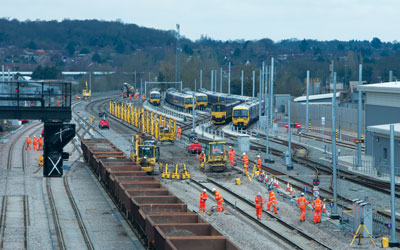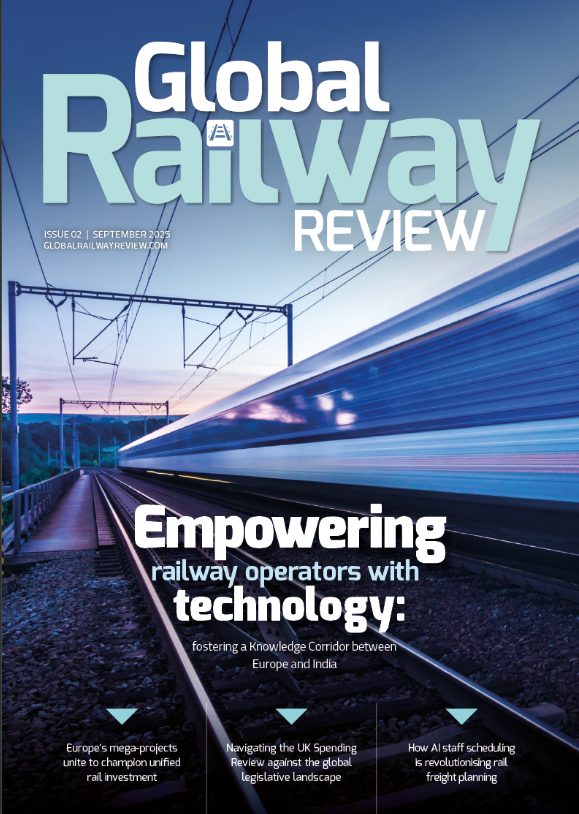The Rail Delivery Group: Developing strategies and proposing solutions
Posted: 4 June 2015 | | No comments yet
Network Rail in the UK has been working with the Rail Delivery Group (RDG) to tackle the cost of contingency on railway projects. Network Rail’s Matthew Hannaway, Head of Project Risk and Value Management and Mike Pollard, Head of Collaborative Working, explain further…


The Rail Delivery Group (RDG) has identified a number of opportunities to improve project outcomes and realise industry-wide benefits. A benchmarking study demonstrated that railway projects cost between 20-30% more than similar construction works by the UK Highway Agency and similar railways in Europe.
The causes of this included different access provisions, applicable safety standards and planning permission processes, but a significant amount of this difference (5-10%) was due to a combination of interparty behaviours not found in collaborative projects. The RDG Asset, Programme and Supply Chain Management (APSCM) Group has established a work stream to improve the identification and management of risk and contingency through better collaboration among industry stakeholders, including Network Rail, Train Operating Companies (TOCs), Freight Operating Companies (FOCs) and Suppliers. The ultimate goal is to reduce the cost of contingency across the rail industry and improve the value it delivers.
High level summary of findings
Rail industry stakeholders generally agree that effective management of cost and risk on a whole industry basis requires engagement of all key stakeholders throughout the project lifecycle. However, the quality of stakeholder engagement in risk and value management is highly variable as a result of the contractual relationships which regulate how the industry operates and limited incentive structures. The valuation of risk and the contractual mechanisms to deal with risk vary widely across Network Rail and its supply chain. Procurement methods also fail to provide all stakeholders with visibility of end-to-end project costs and risks, and lack incentives that encourage cross industry approaches to effectively manage these costs and risks.
At present, the industry generally adopts a fragmented approach to risk and value management where threats and opportunities are owned and managed by individual parties. Risk identification and value management is predominantly assessed and managed by the supplier community or Network Rail, with minimal or no input from TOCs and FOCs. Whilst apportioning risk in theory creates accountability, the complicated nature of delivering projects in a railway environment means that no single party is able to achieve the best outcome for the end-users of the railway.
The approach
To address this, the APSCM Cost of Contingency work stream is developing a series of contract models to enable an industry wide contractual framework. This facilitates the implementation of an Enterprise Risk and Value Management framework that focuses on value creation and protection through proactive management of risk in a prioritised, effective, consistent and efficient manner. Through this collaborative Risk and Value Management framework the total (transparent) cost of risk can be understood, communicated and contingency more effectively managed to optimise utilisation.
A comparison of key features of rail project contingency
Included in the comparison of key features of rail project contingency are:
- Contingency can be either explicit or implicit. Explicit contingency results from risks which are recognised, defined and modelled in a risk process. Implicit contingency is built into (hidden in) industry rate structures. Implicit contingency is based on previous experience, and built around the stigma of payment for changes in their various manifestations (scope, time, access etc.) and ultimately the protection of profit.
- Collaborative contracting strategies promote shared risk identification and management, opposed to risk allocation. Explicit risks are managed through a collaborative risk provisioning fund and contractual provisions promote this to be mitigated or managed. The shared objective is to reduce contingency allowances by improving decisions made throughout the project lifecycle. The opportunities for sharing ideas and building on the ideas of others, maximises the opportunity for risk to be managed or value to be created.
- The transparency around collaborative contracting should result in contractor opportunity for cost growth being built into the collaborative risk fund (i.e. the no claims objective drives some of the implicit contingency to become explicit). As the Contractor is rewarded for accepting and managing risk there may be issues which traditionally would have been retained by the client (i.e. interface with other stakeholders) which the Contractor is happy to be managed by the collaboration.
- While there is still implicit contingency in the collaborative contract stack it is hoped that this will be significantly reduced over time. Such improvement results from cost being better understood (via the Rail Method of Measure, Unit Cost Modelling and shared commercial management), coupled with the supply chain becoming more trusting of the relationships and of the process. As this happens, more of the contingency built into rate structures becomes explicit.
Key enablers
RDG are developing a number of collaborative contract models that enables the risk and value management processes described above and encourages collaboration across the rail industry. This builds on measures already taken by the Department for Transport (DfT) and the Office of the Rail Regulator to encourage broader integration across the industry. The plan is to develop a library of Industry Integration Agreement Models that cover the development and delivery planning of railway projects. The outputs of these will inform the ‘value for money statements’ provided to the contractors that will deliver the design and construction works. RDG have developed an Alliance model which accommodates cross industry engagement. The Alliance model is based on the lessons learned from UK railway projects and is consistent with the best-practice promoted by Infrastructure UK (Improving Infrastructure Delivery: Alliancing Best Practice in Infrastructure Delivery).
Each of the contract models will be supported by its own set of guidelines which promote the correct business processes and behaviours that are necessary for their successful development, negotiation and agreement.
The collaborative risk and value management framework and contract models are tools which define arrangements and process that if adopted, will reduce the cost of contingency. The broader challenge is developing a risk and value management culture across the rail industry. Early thought is to develop a community of practice in both physical and virtual form that allows industry members to share their stories of adoption. Through the process of sharing information and experiences, members will learn from each other and have an opportunity to build on what has been developed by others.
Reference
About the authors




OUT NOW: The Definitive Guide to Rail’s Digital Future
The rail industry is undergoing a digital revolution, and you need to be ready. We have released our latest market report, “Track Insight: Digitalisation.”
This is not just another report; it’s your comprehensive guide to understanding and leveraging the profound technological shifts reshaping our industry. We move beyond the buzzwords to show you the tangible realities of AI, IoT, and advanced data analytics in rail.
Discover how to:
- Optimise operations and maintenance with real-time insights.
- Enhance passenger services through seamless, high-speed connectivity.
- Leverage technologies like LEO satellites to improve safety and efficiency.
Featuring expert analysis from leaders at Nomad Digital, Lucchini RS, Bentley Systems and more, this is a must-read for any rail professional.
The rest of this article is restricted - login or subscribe free to access


Why subscribe? Join our growing community of thousands of industry professionals and gain access to:
- Bi-monthly issues in print and/or digital format
- Case studies, whitepapers, webinars and industry-leading content
- Breaking news and features
- Our extensive online archive of thousands of articles and years of past issues
- And it's all free!
Click here to Subscribe today Login here







